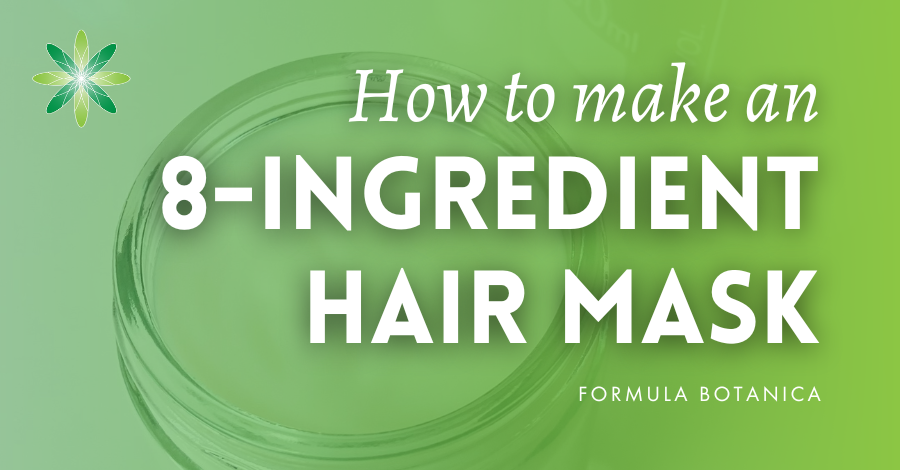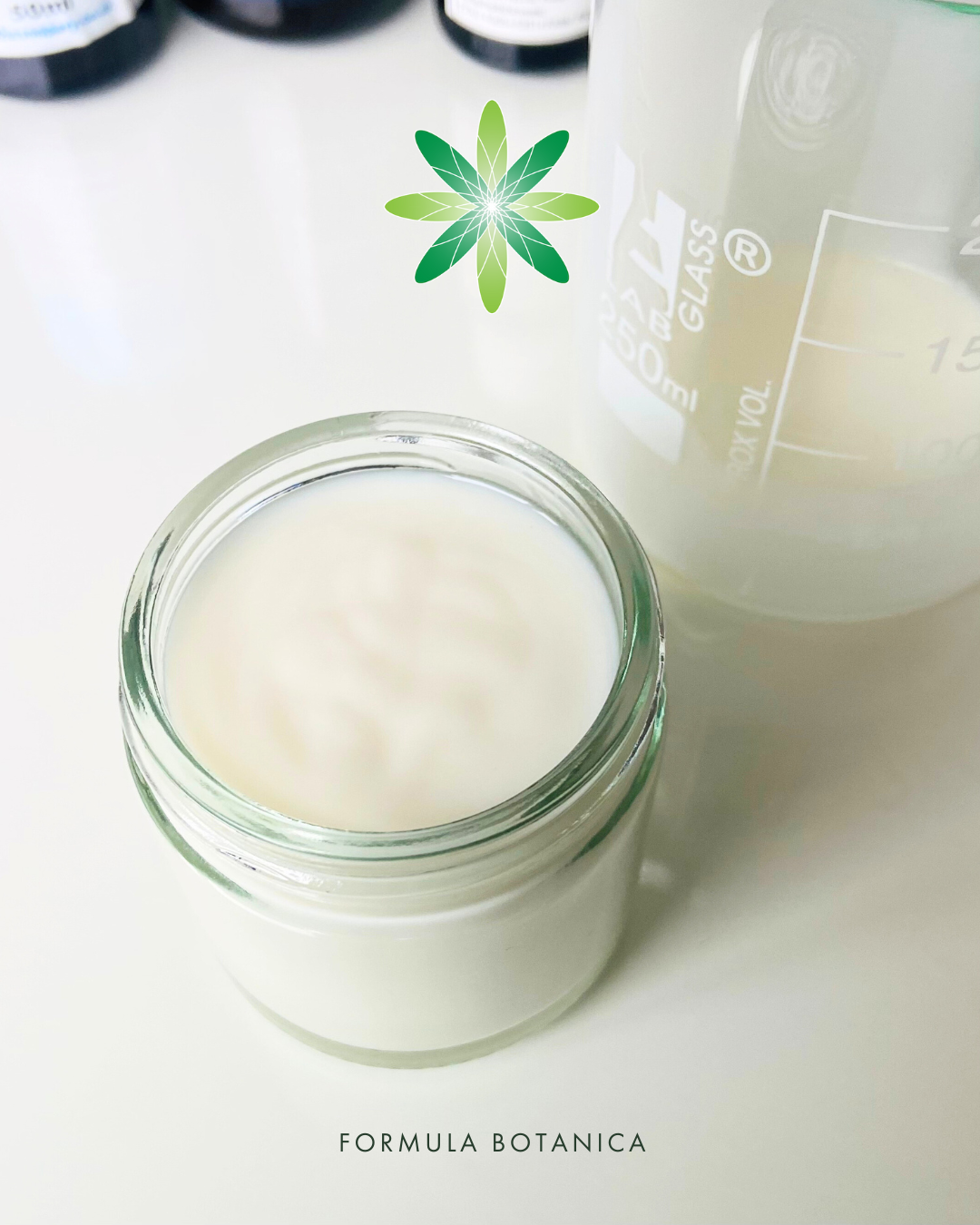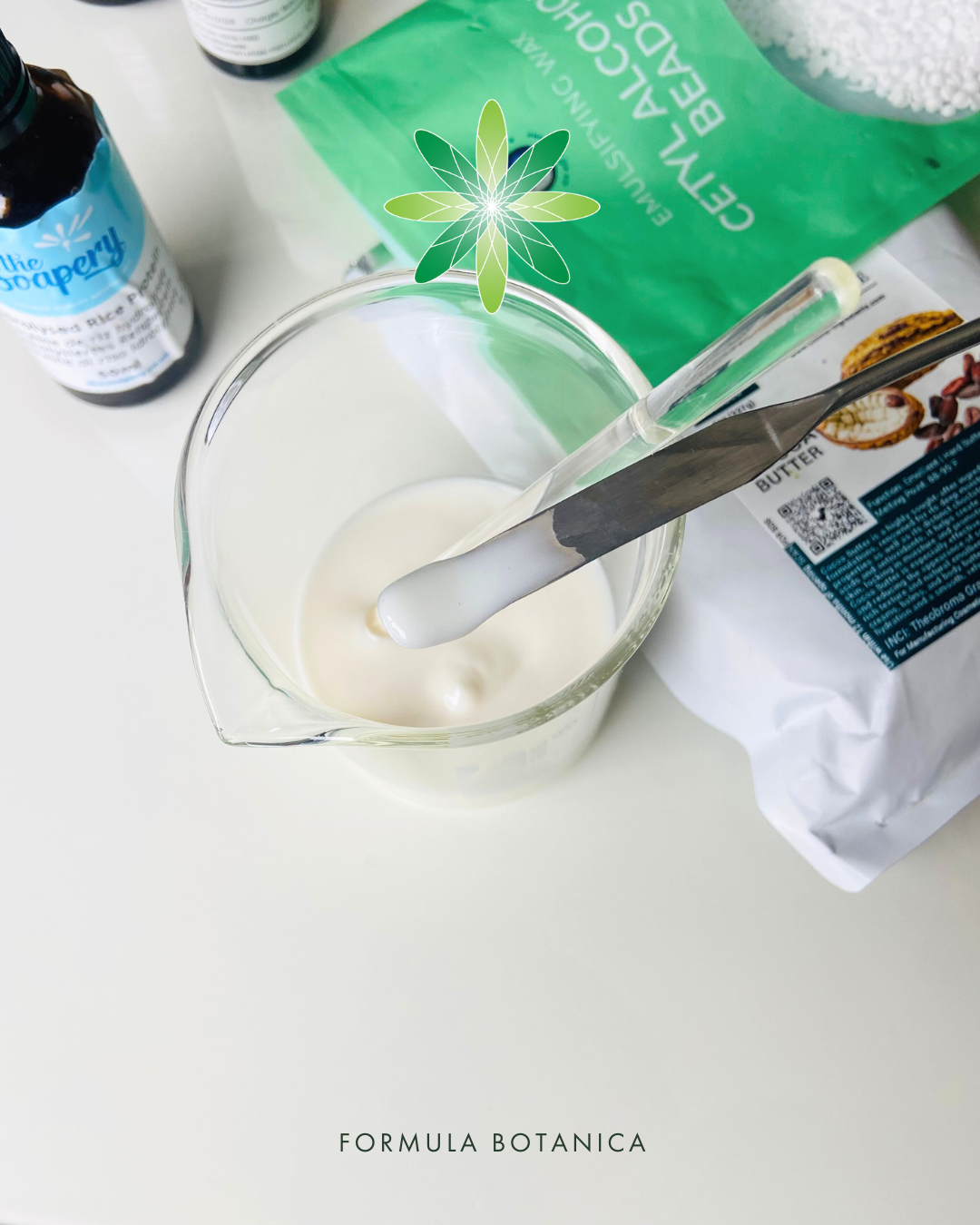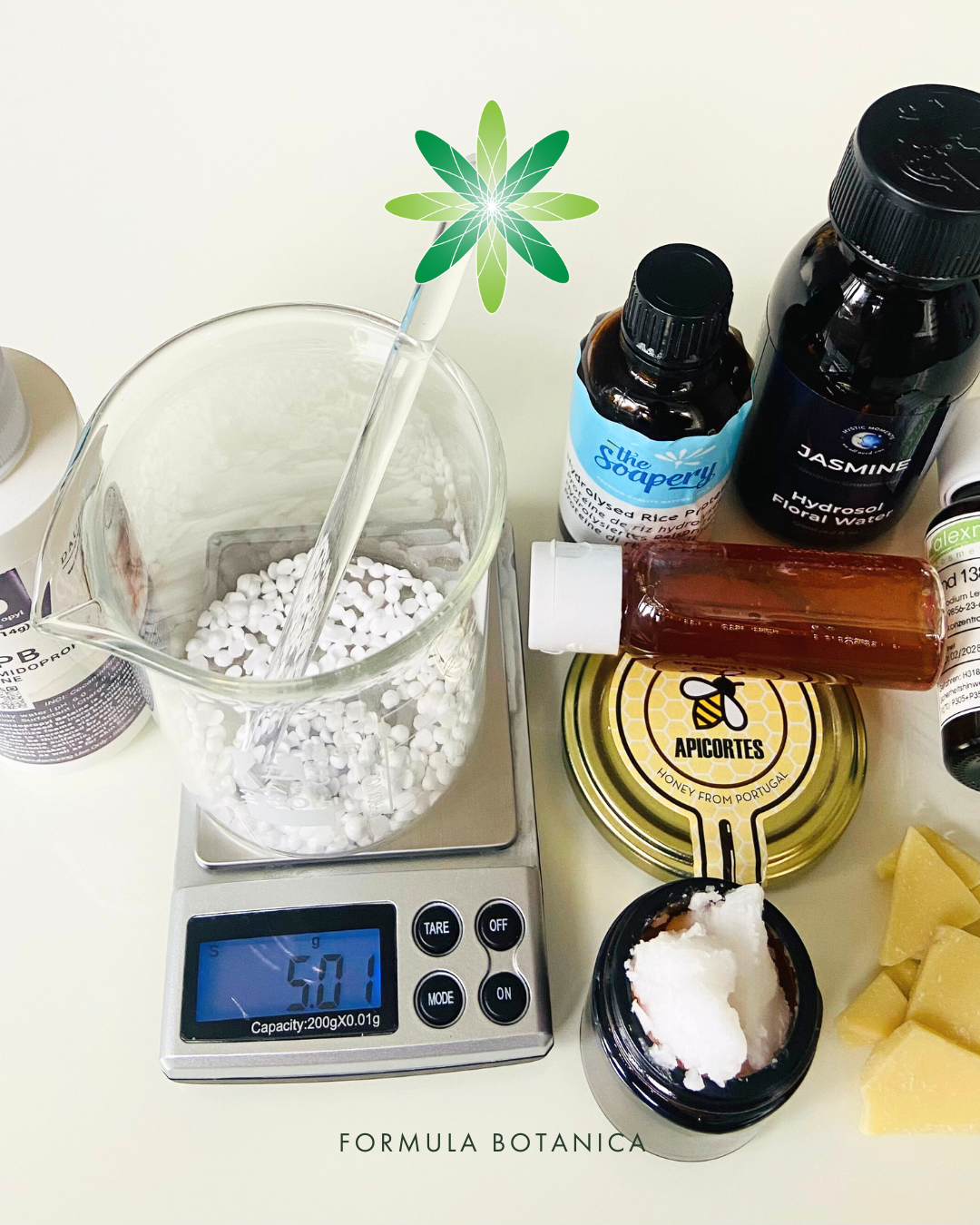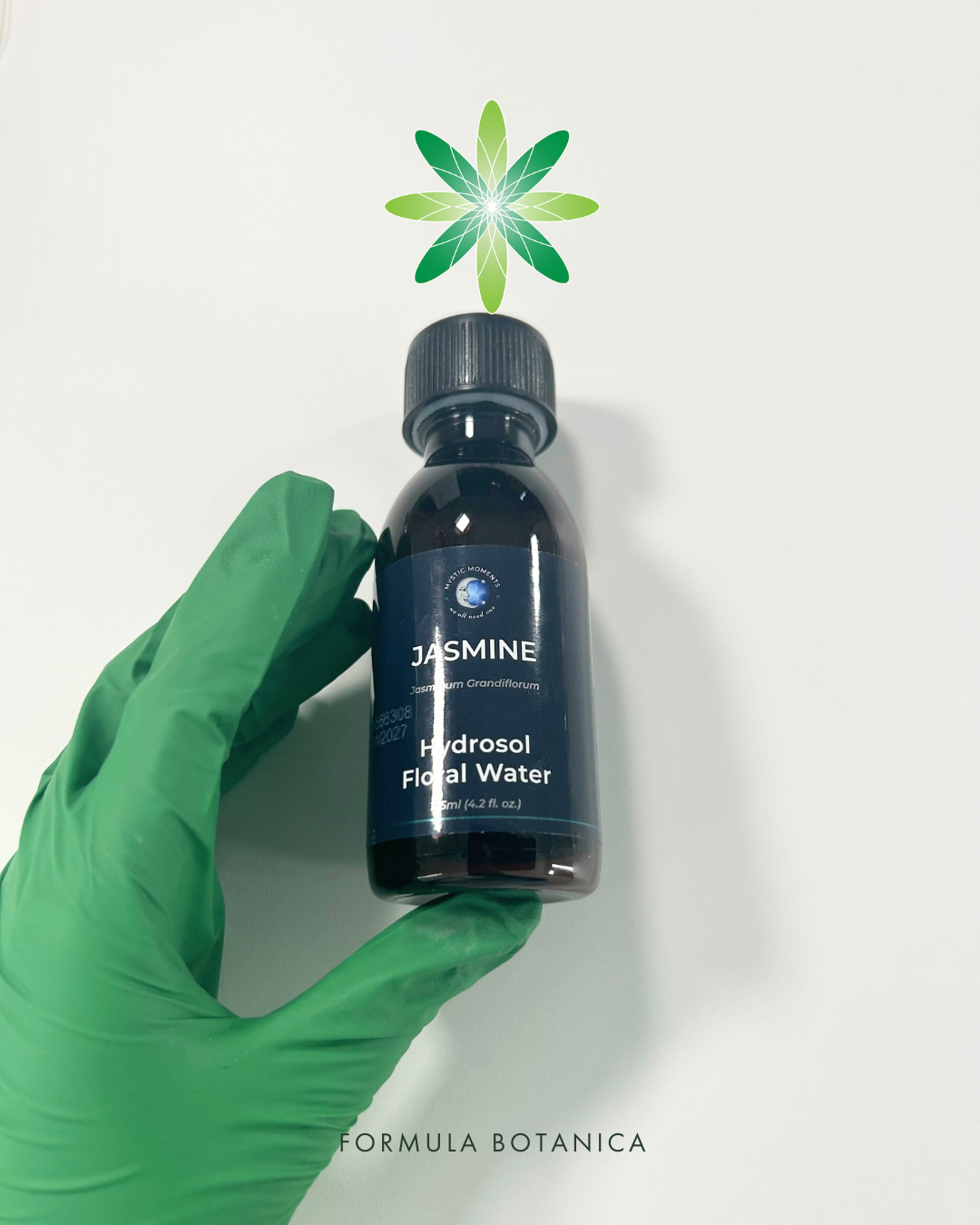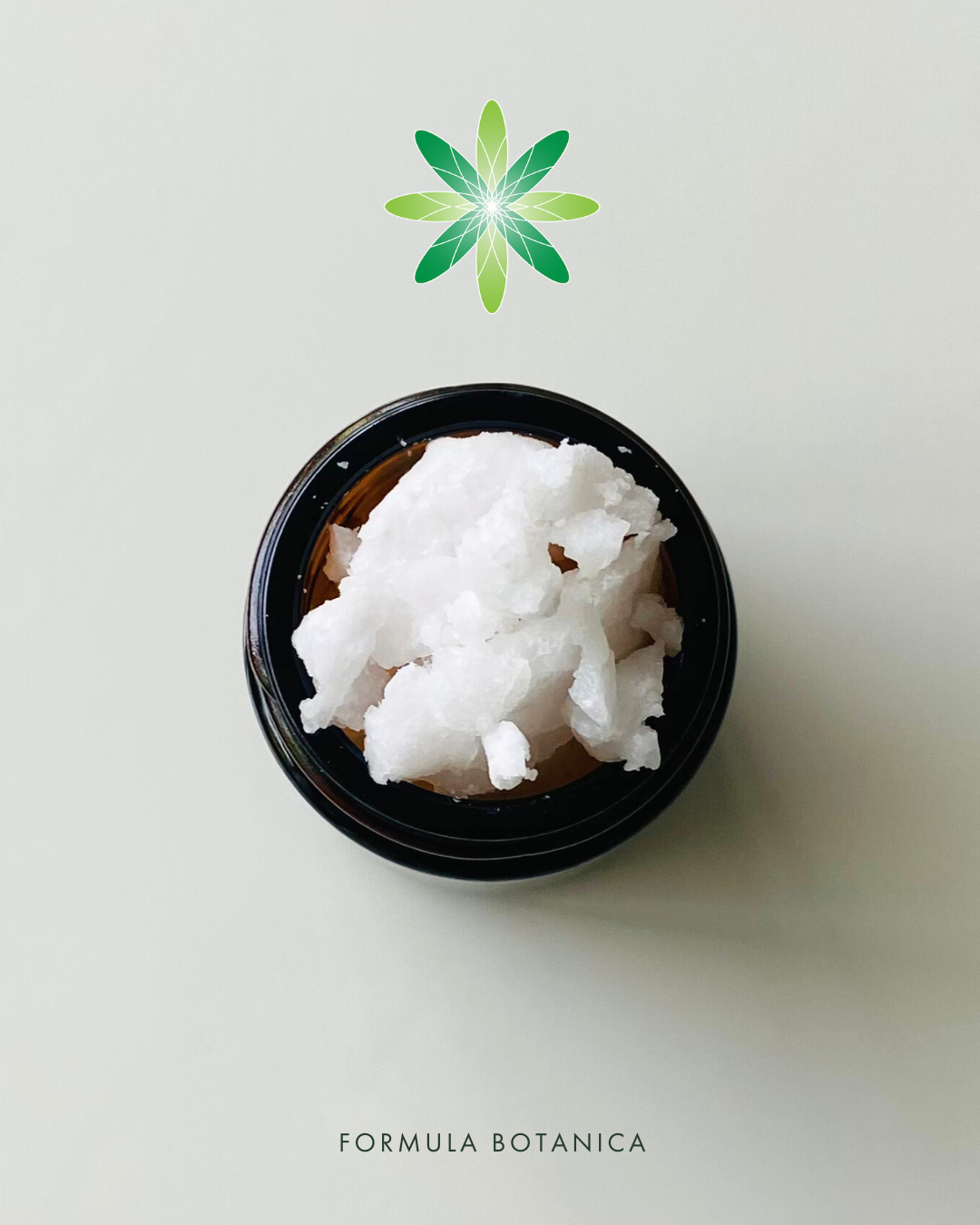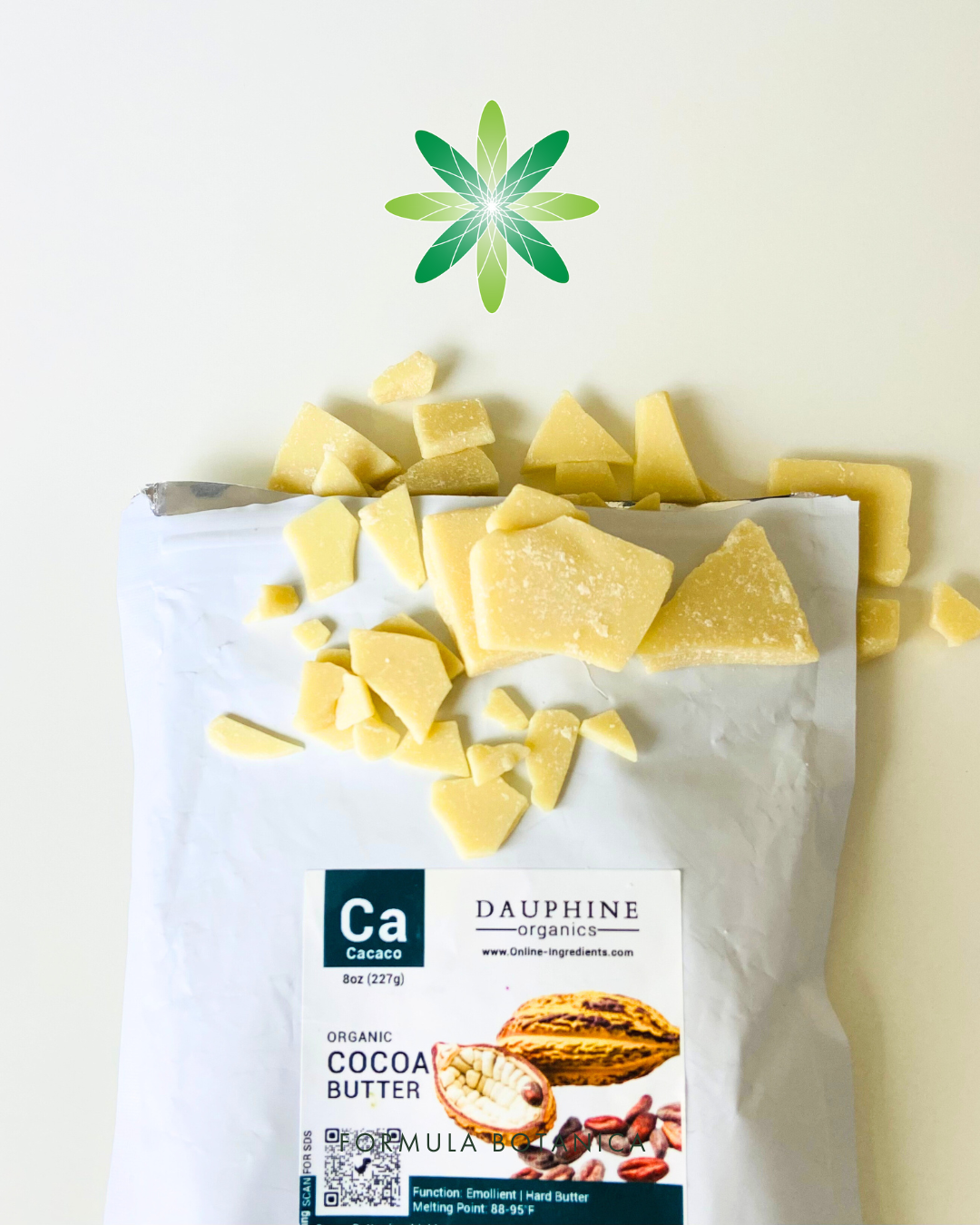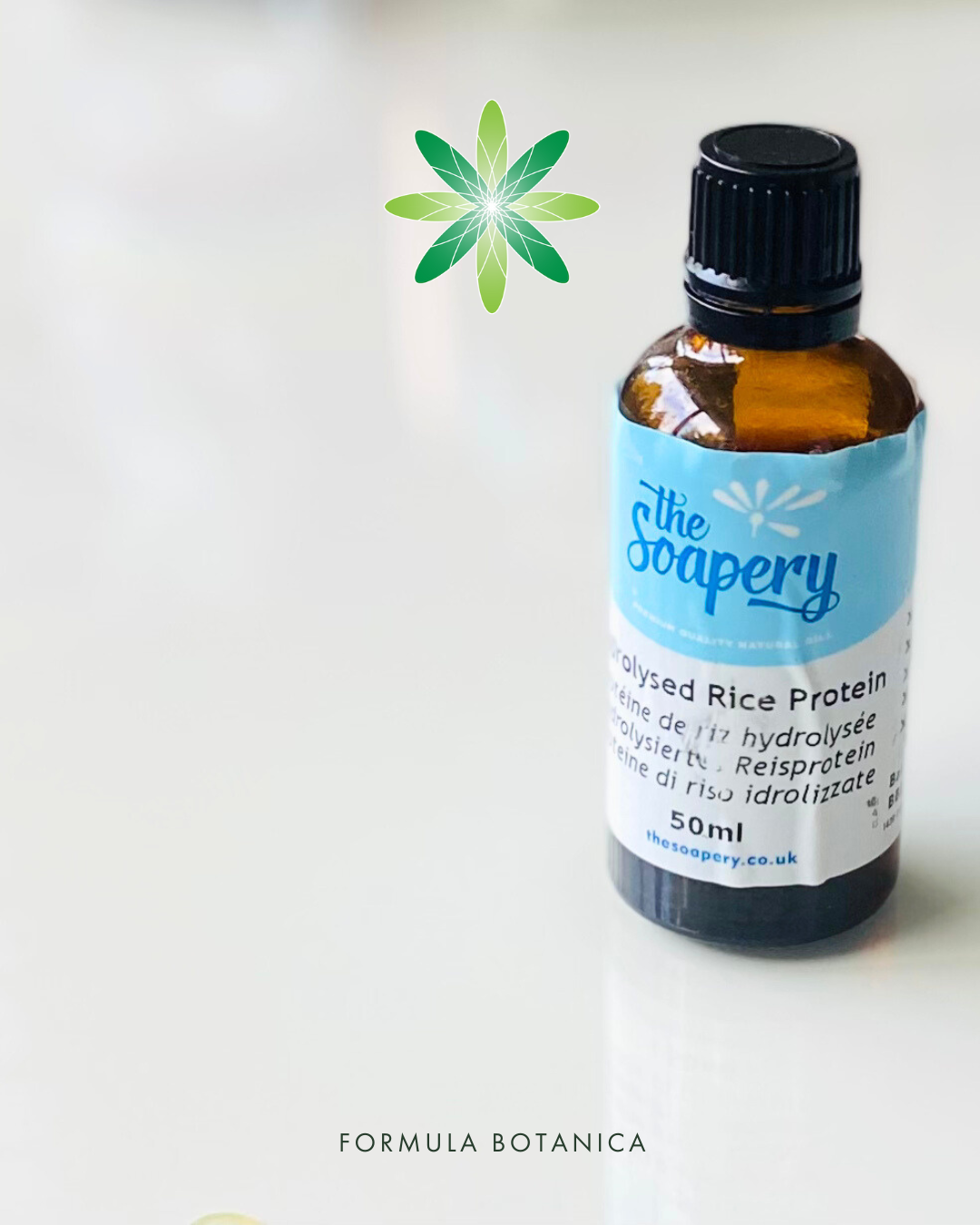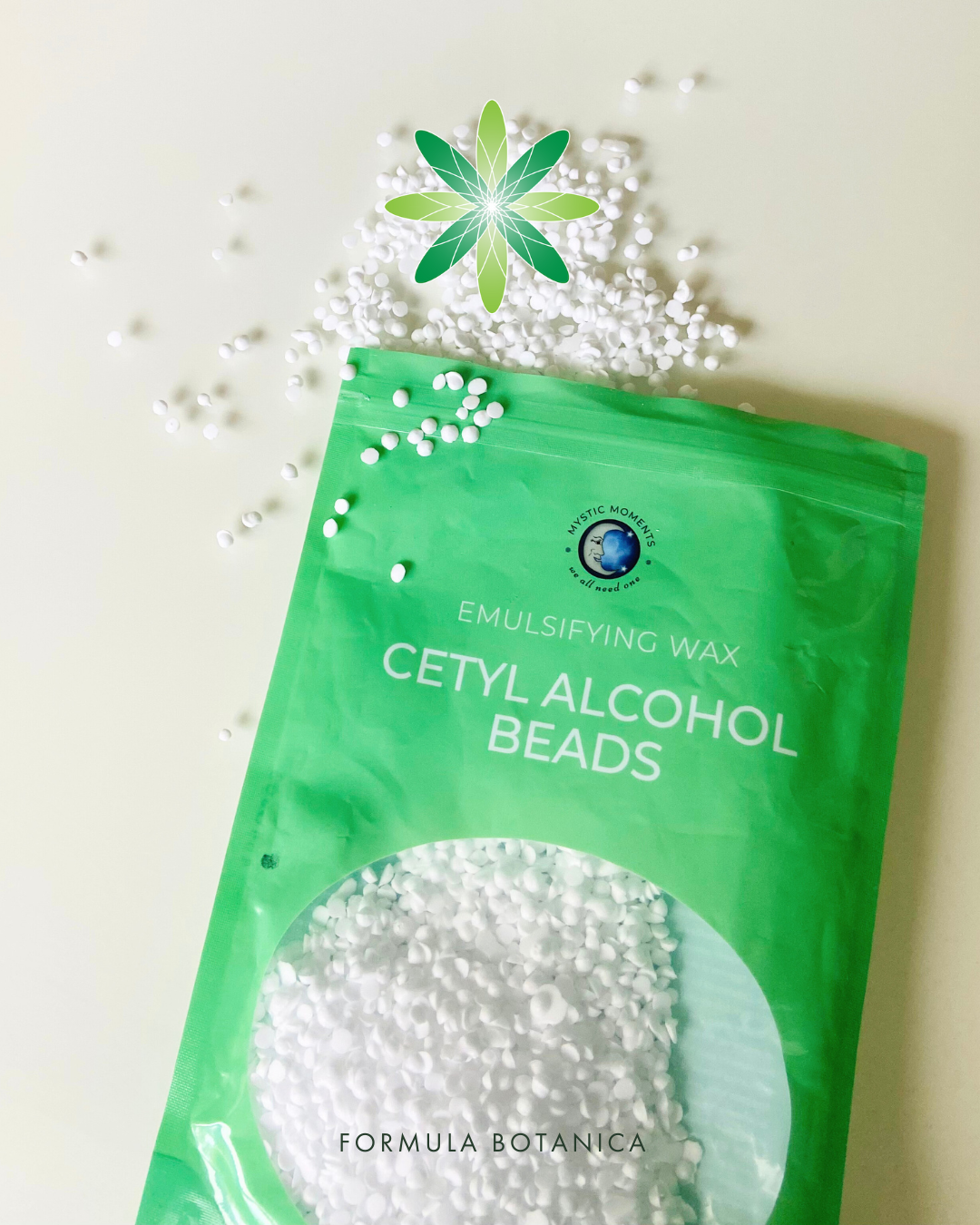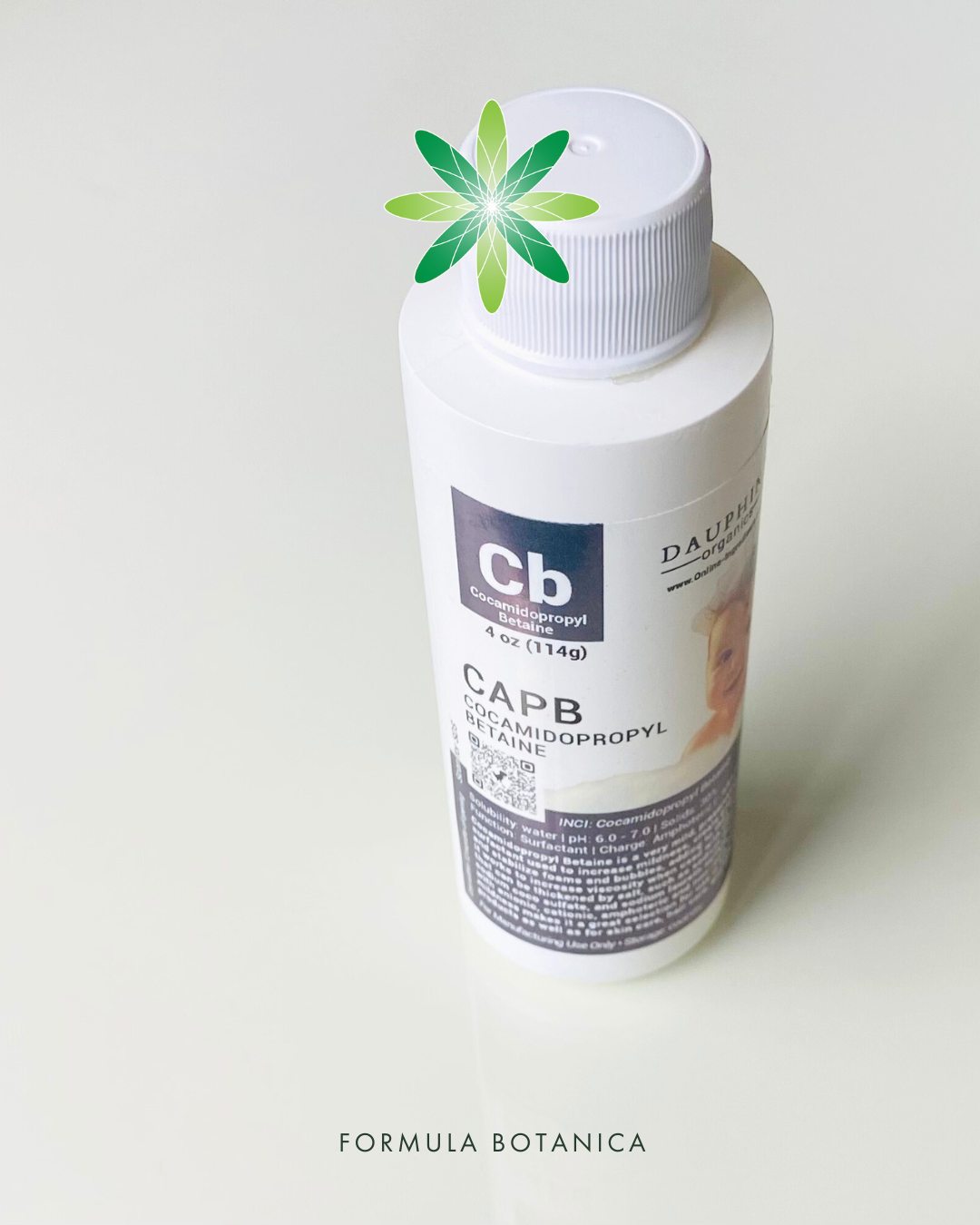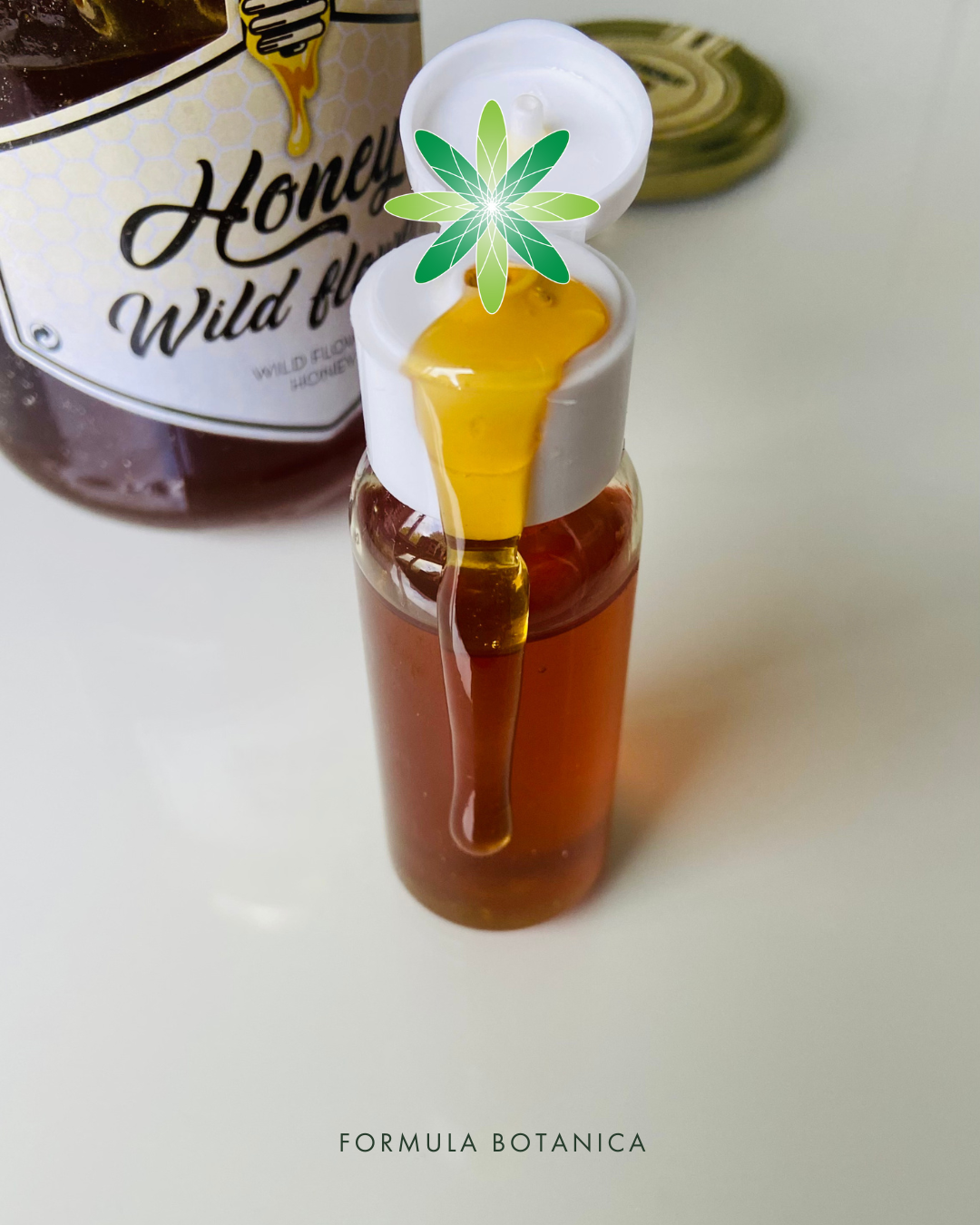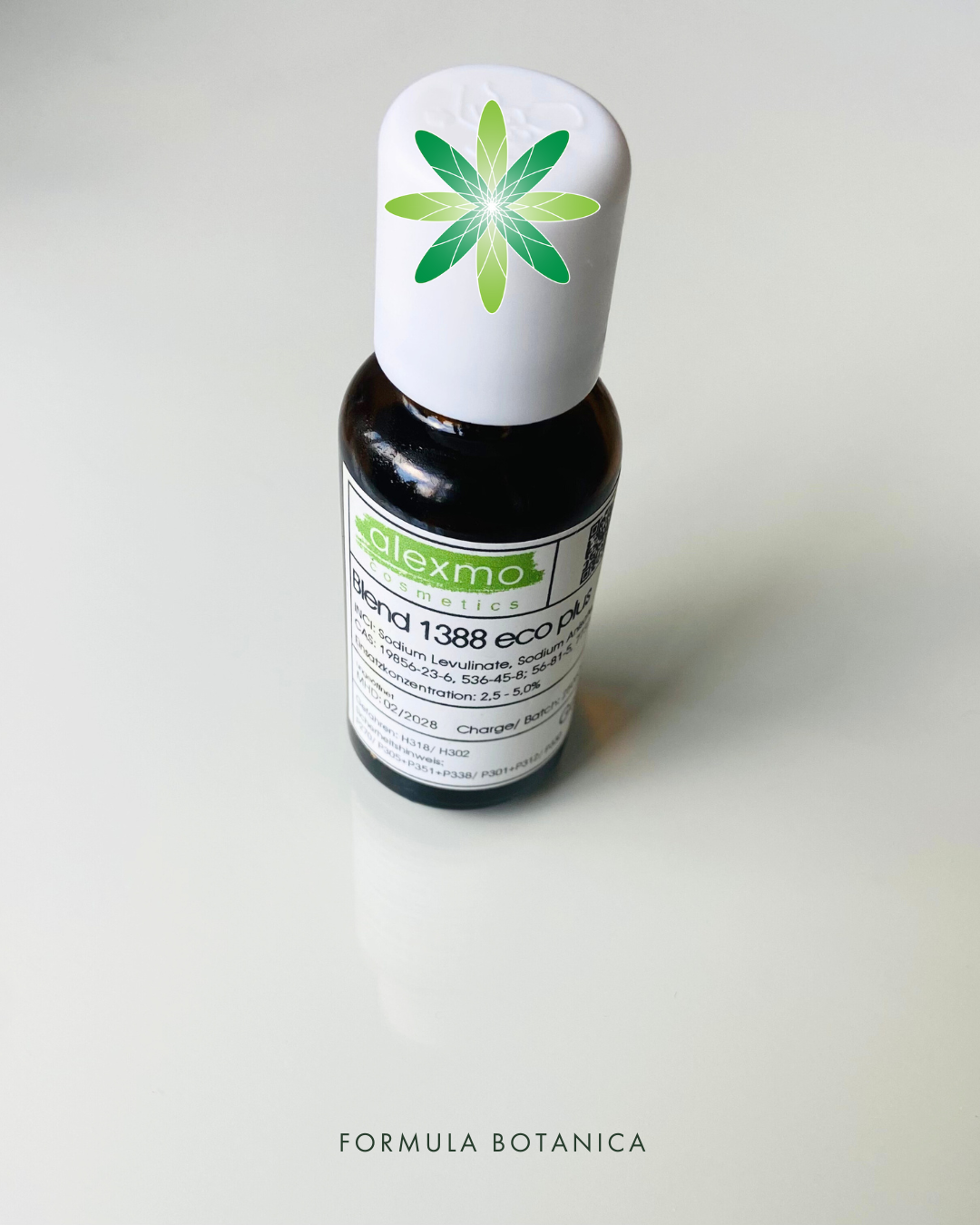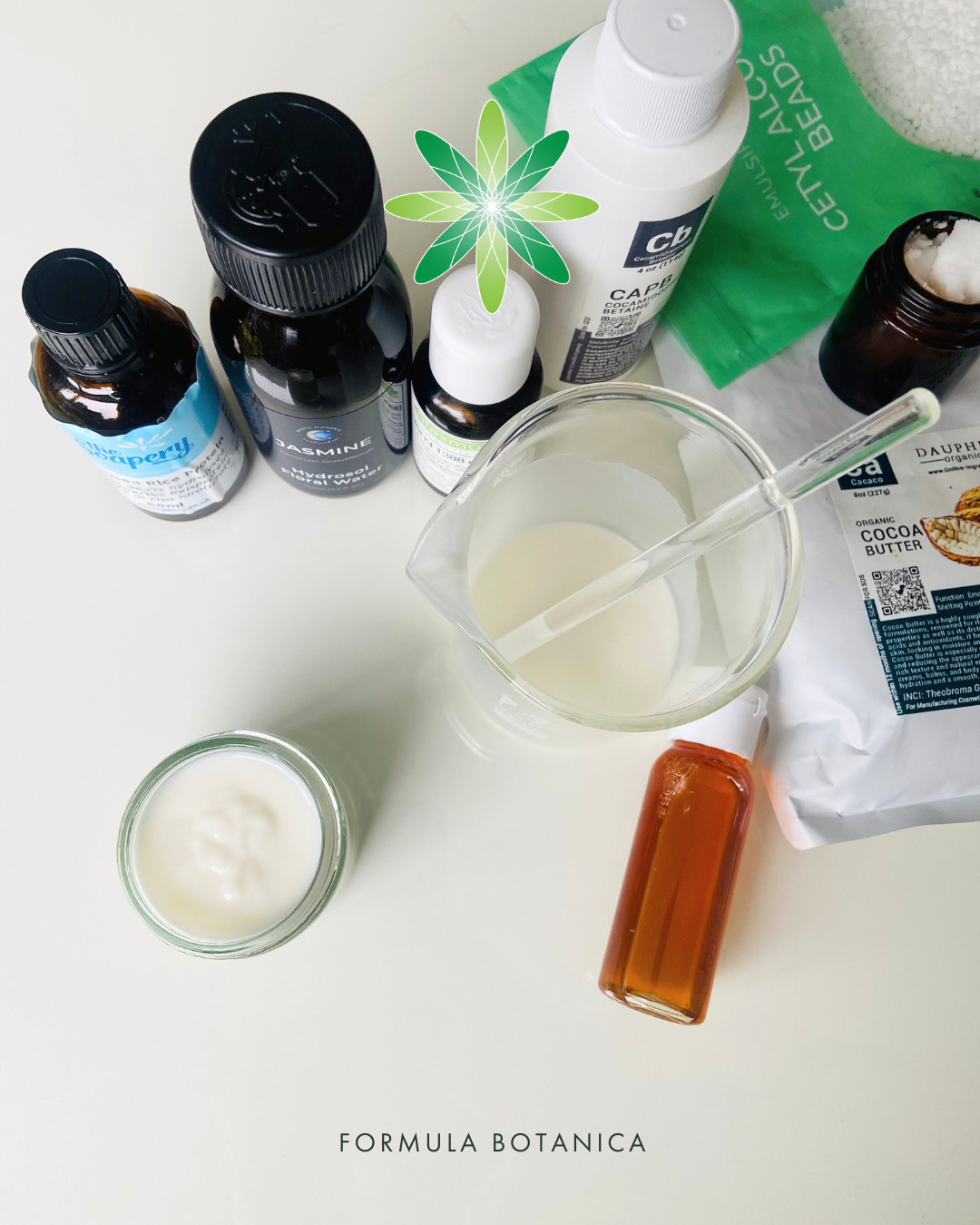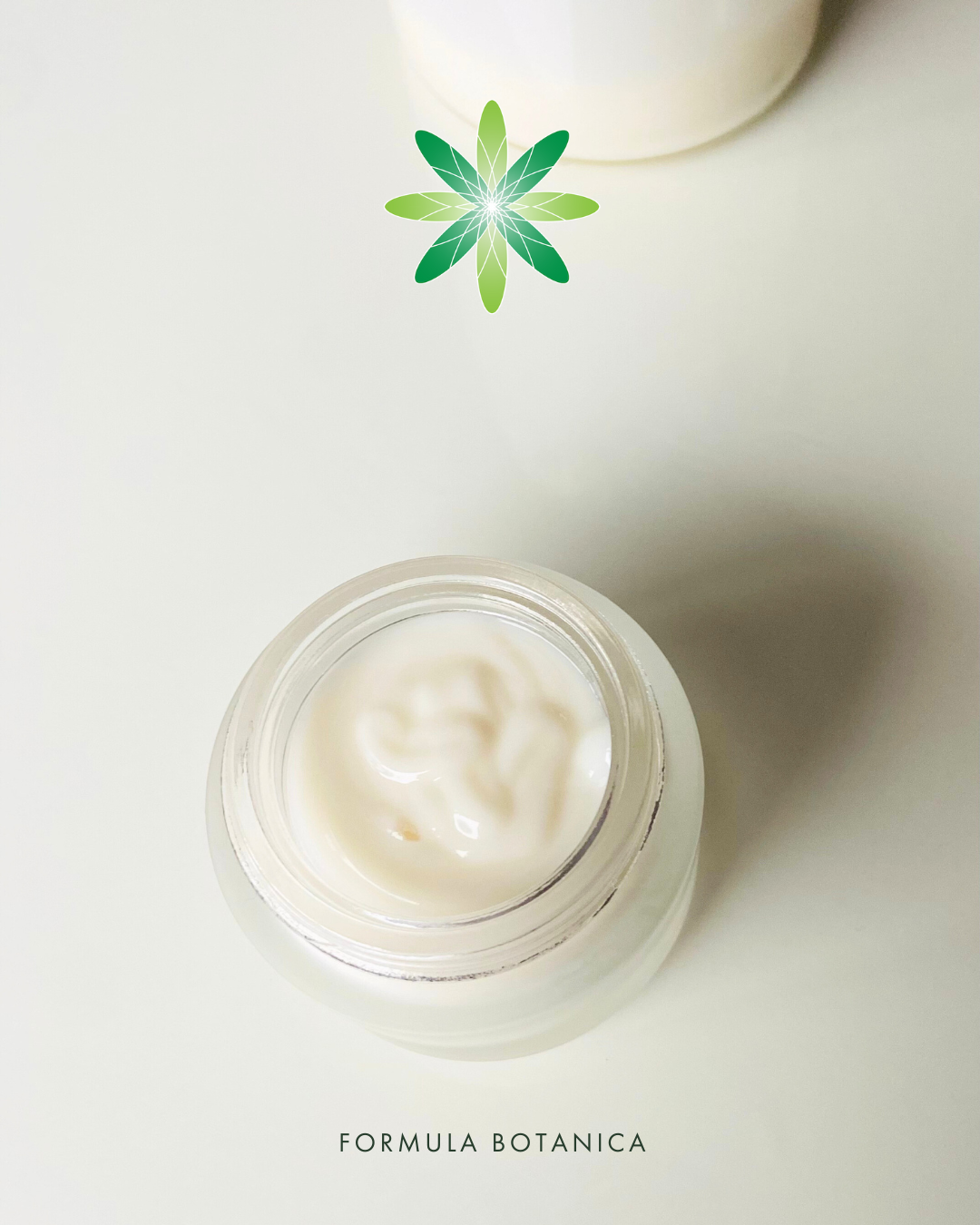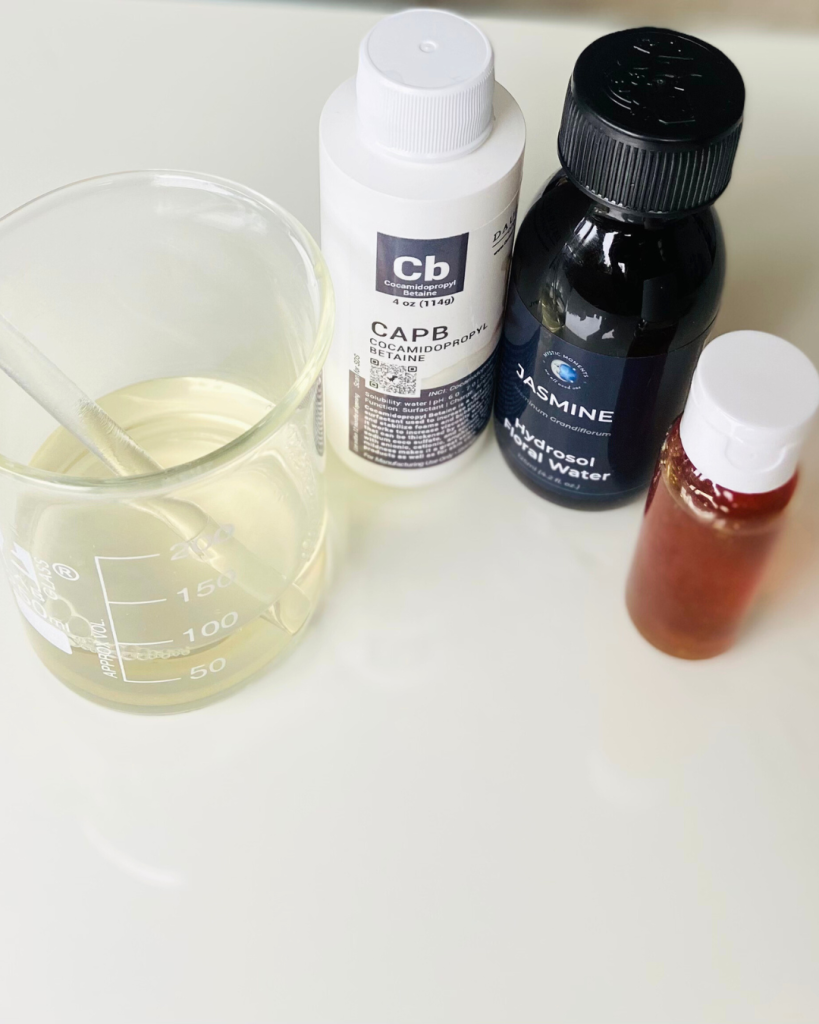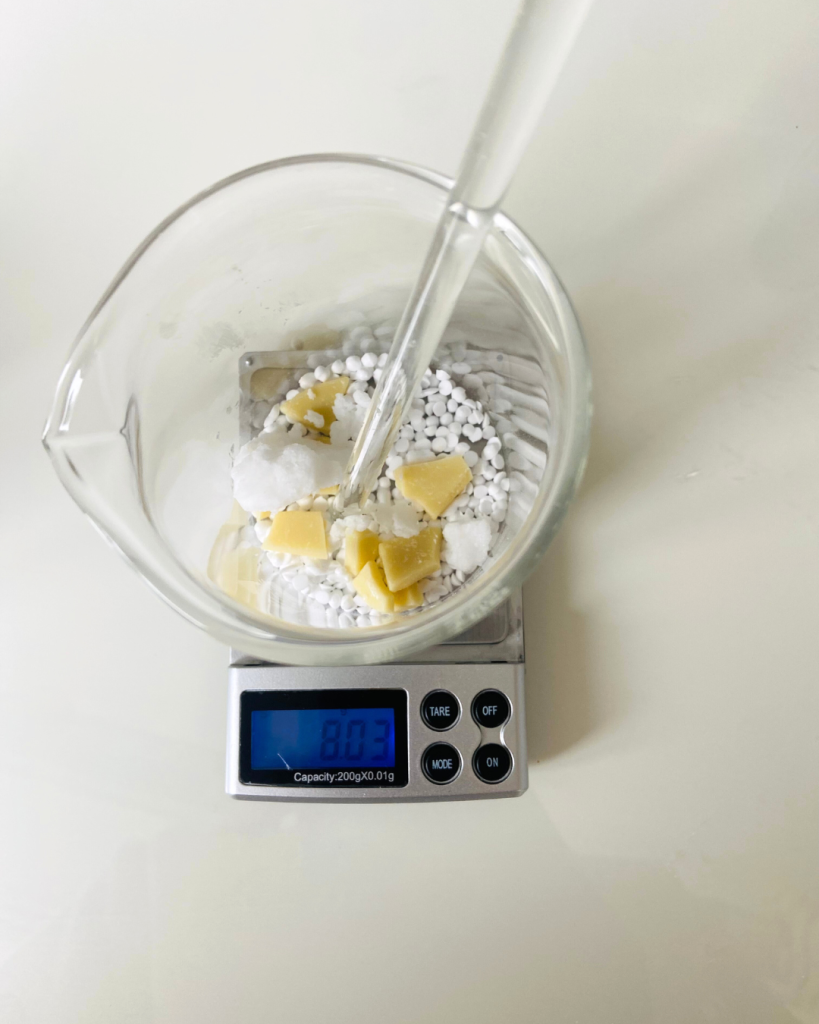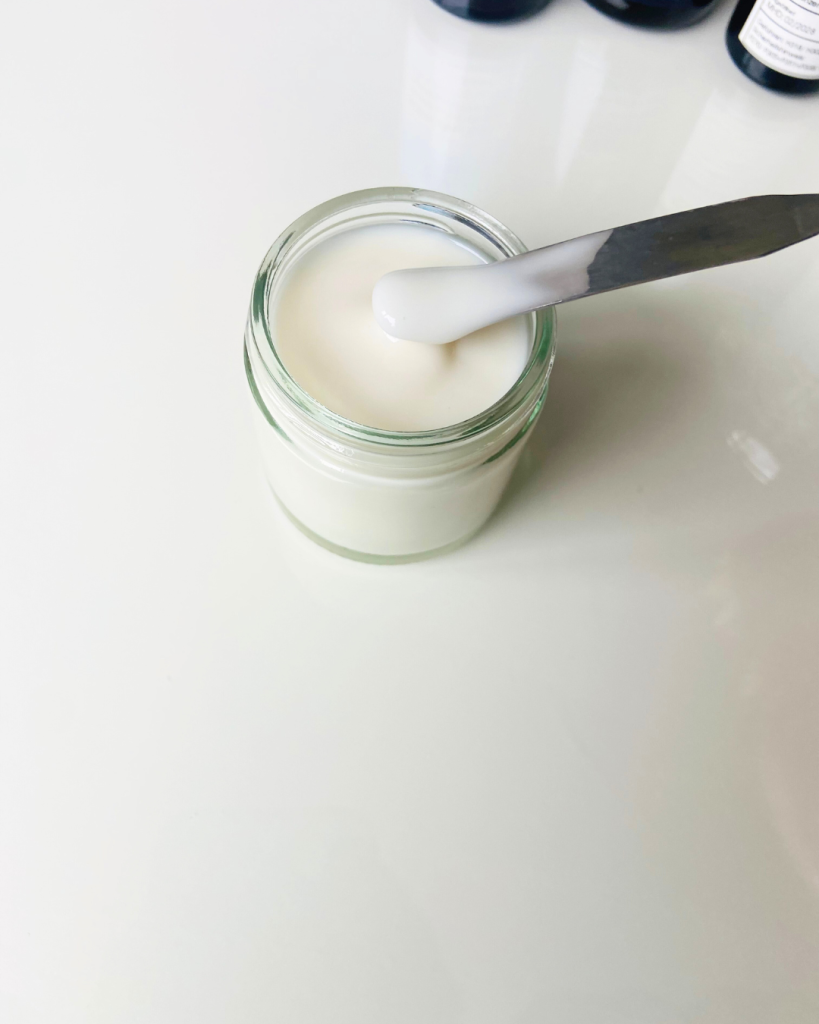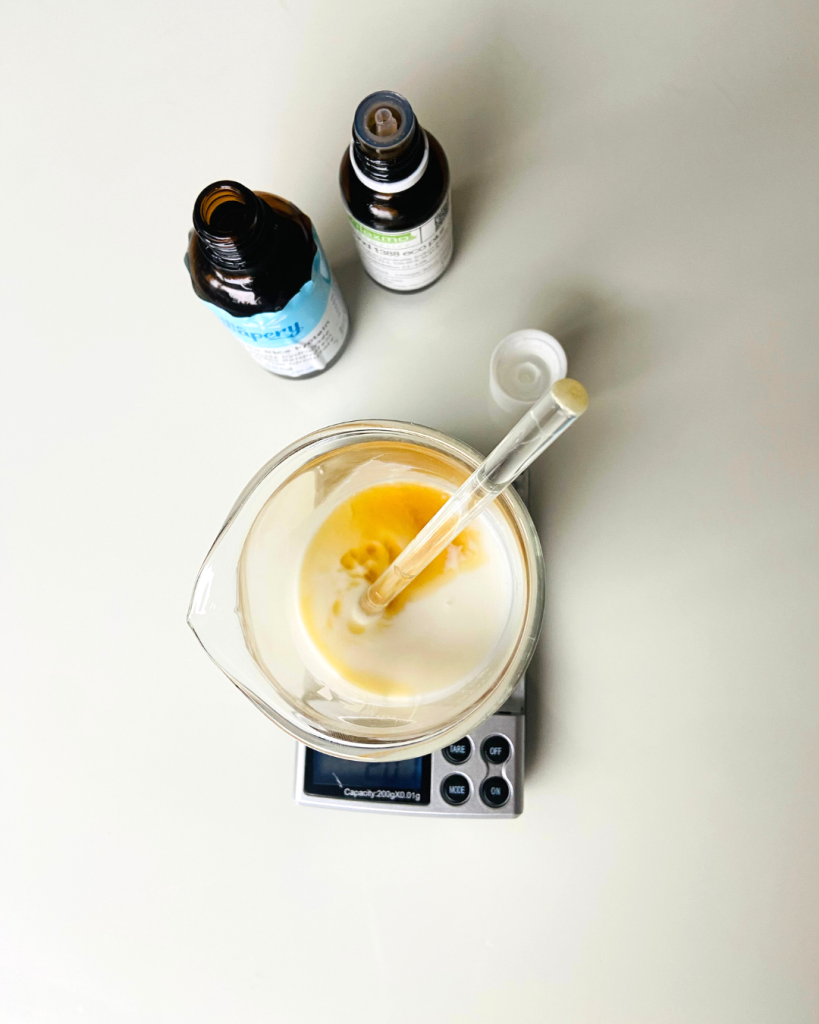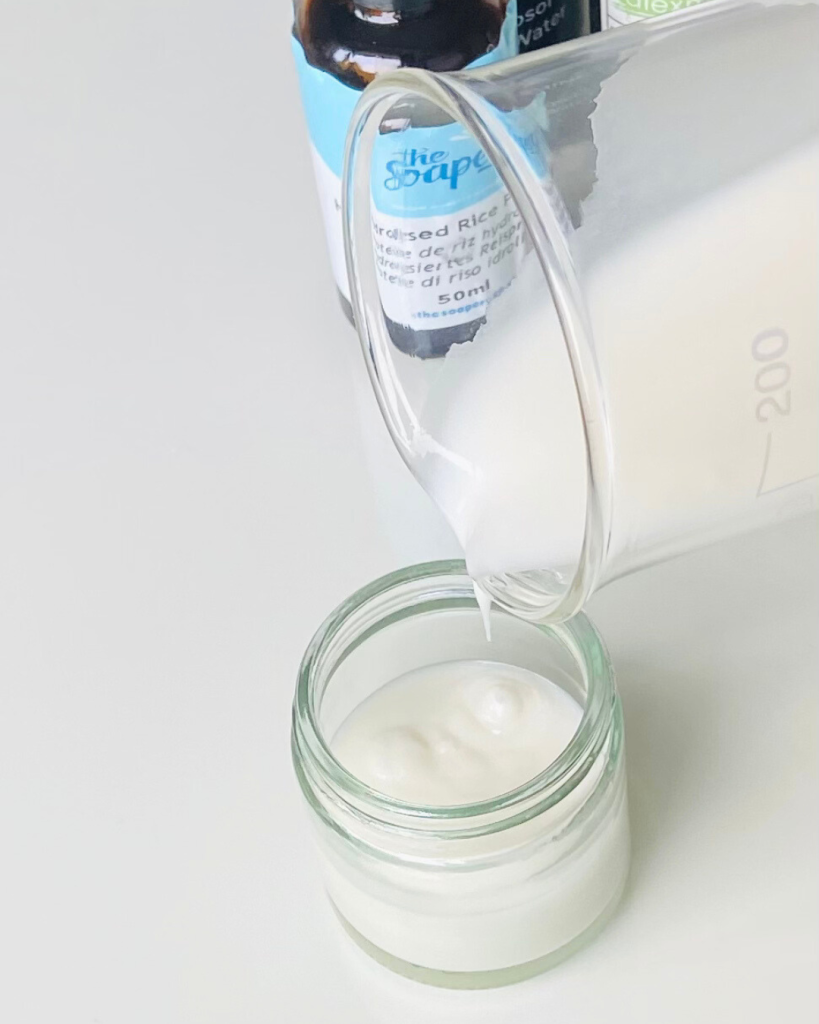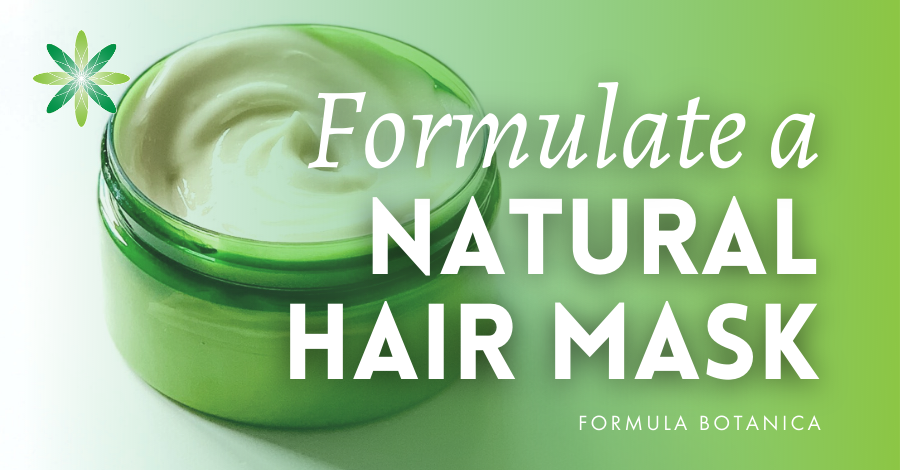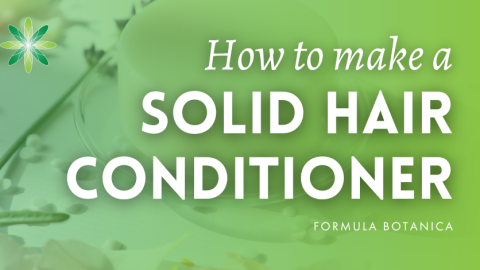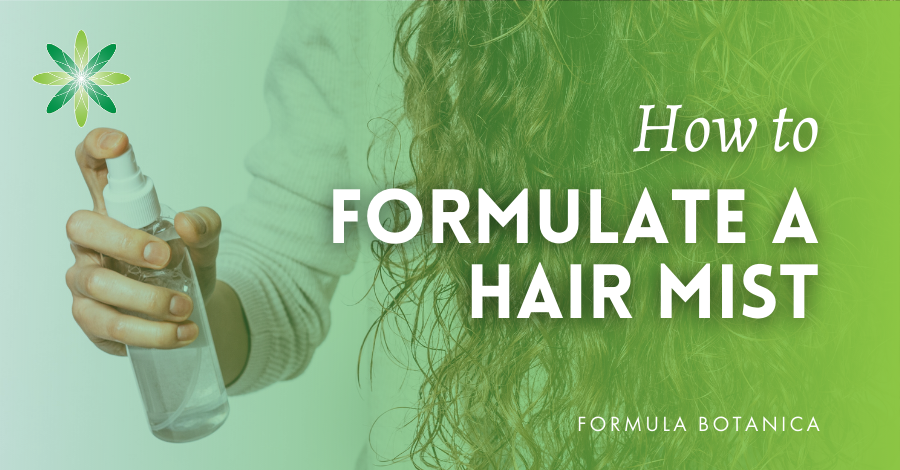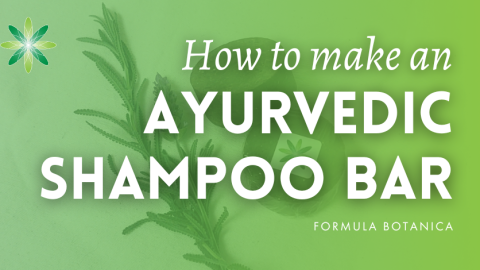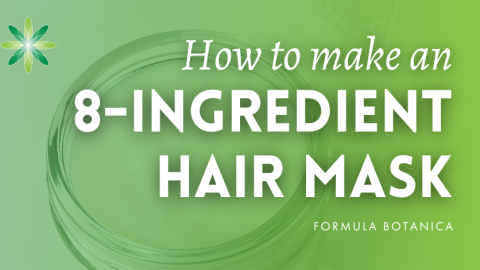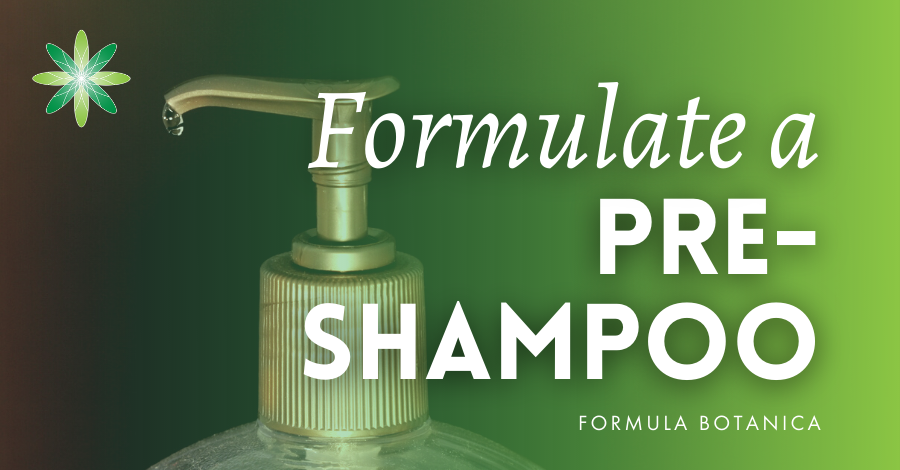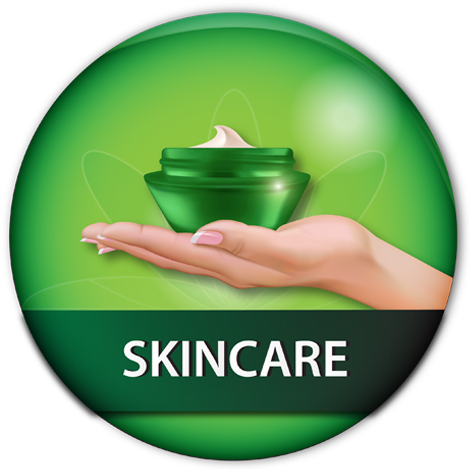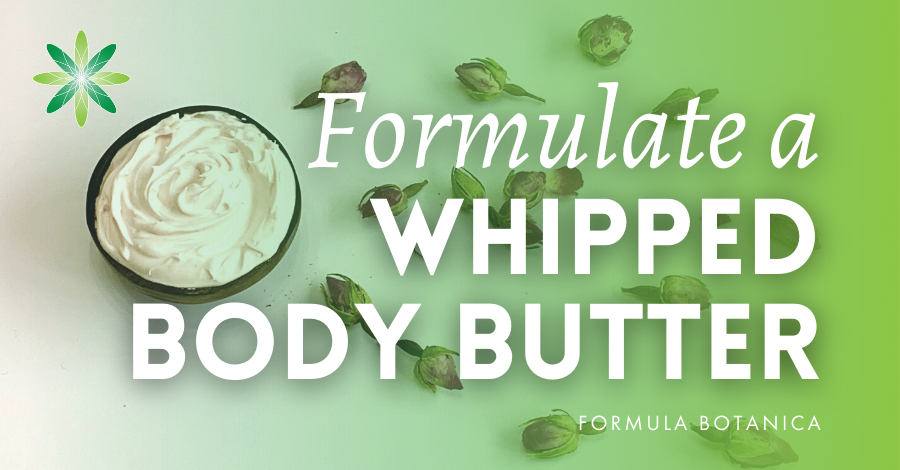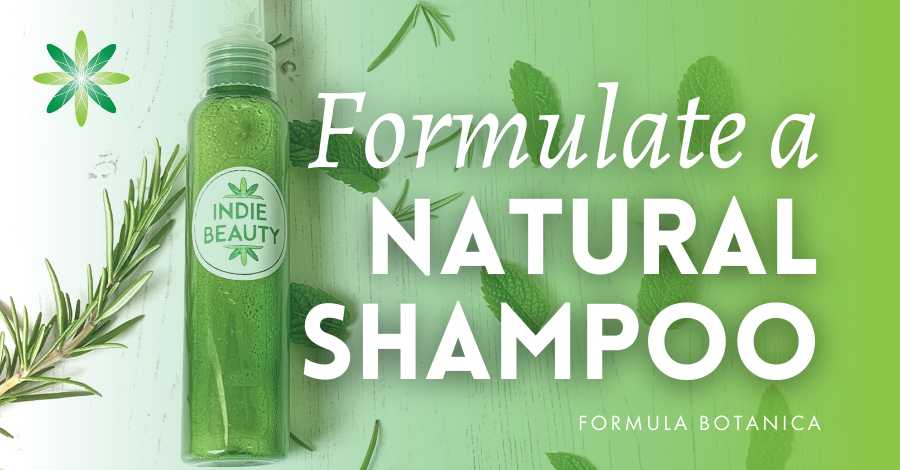Would you like to make your own natural hair mask from scratch, but aren’t sure where to start? You’ve come to the right place!
I’m Natalie, the Cosmetic Scientist here at Formula Botanica, the world’s leading online organic cosmetic formulation school. I’ve been formulating ever since I was a child, mixing up whatever ingredients I could find in my mom’s kitchen to make my own skincare and haircare – long before DIY beauty was even a thing!
Today, I’ll be showing you just how easy (and fun!) it is to make your own products from home. We’ll be creating a luxurious coconut and honey hair mask using only eight ingredients, most of which you probably already have in your kitchen.
What I love the most about this mask – apart from how easy it is to make – is that it smells like a soft floral bouquet and that it leaves your hair feeling deeply nourished and silky smooth. I guarantee that once you try it, you’ll never want to buy another hair mask again!
The inspiration behind this coconut & honey mask
The idea for this hair mask was to create something simple yet luxurious, using ingredients you readily have available at home, like honey and coconut oil and to combine them with natural cosmetic ingredients, which are widely available, wherever you are in the world!
You’ll find a list of suggested suppliers at the end of this post.
Why you’ll love this hair mask
Not only is this mask quick and easy to make – and uses just eight ingredients – but it’s also genuinely effective (if I can say so myself!).
I have coily hair, and this formula deeply moisturises and strengthens my hair shaft, helping improve elasticity and boost natural shine.
I also love how customisable it is. Oh, and did I mention it’s natural?
What it looks, smells, and feels like
This coconut and honey hair mask has a smooth, velvety cream texture with a rich yet lightweight feel that glides effortlessly through the hair. It smells like a soft floral bouquet, with gentle hints of jasmine and honey.
What you need to make it
Here’s everything you’ll need to make this luxurious coconut and honey hair mask:
Ingredients
This hair mask combines luxurious plant-based emollients (moisturising ingredients) like coconut oil and shea butter with lightweight humectants, which are a type of cosmetic ingredient that draws water to the hair to keep it hydrated. You can learn more about humectants below:
It also has proteins to soften, smooth and strengthen the hair shaft, plus jasmine water for a subtle floral scent and a soothing touch.
Below is an overview of all the ingredients I’ve used in this mask and their benefits. These are some of my favourite ingredients to use because they’re easily accessible, mix well with each other, and can be adjusted depending on your hair’s needs!
1. Jasmine water
INCI: Jasminum Officinale Flower Water
Firstly, you’ll need jasmine water. Jasmine water is a gentle, soothing floral hydrosol that helps refresh the scalp and imparts a subtle, uplifting fragrance to the hair mask.
A hydrosol is an aromatic water produced from the steam distillation of plants (in this case, jasmine flowers). You can learn more about hydrosols below:
Pro tip: If you don’t like the smell of jasmine, you can always swap it with rose, neroli, or lavender hydrosol – or any other you’d like! You could also just use distilled water, which is available everywhere.
2. Coconut oil
INCI: Cocos Nucifera
Next, you’ll need coconut oil, which you might already have at home. I used the one from my kitchen cupboard!
Coconut oil helps nourish the hair shaft, reduce protein loss, and add lustre to the hair. It’s also excellent for repairing damage and improving manageability.
3. Cocoa butter
INCI: Theobroma Cacao Seed Butter
You’ll also need cocoa butter, which you might already be familiar with. This natural butter provides deep nourishment to the hair, smooths the cuticle, and locks in moisture.
It also contributes to the creamy, luxurious texture of the mask. Plus, it smells deliciously chocolatey!
4. Rice protein
INCI: Aqua, Hydrolysed Rice Protein, Sodium Benzoate
Next, you’ll need rice protein, which you can find in cosmetic ingredient shops worldwide.
I added it to the mask because it helps strengthen hair, boost volume, and improve elasticity. It also forms a protective layer that enhances hair smoothness without weighing it down.
5. Cetyl alcohol
INCI: Cetyl Alcohol
The fifth ingredient you’ll need is cetyl alcohol, which also happens to be one of my favourite ingredients here, even if it may not seem like the most exciting one!
If you’re not familiar with it, cetyl alcohol is a fatty alcohol commonly used in cosmetic formulations as an emulsifier (it helps oil and water to mix). In this mask, cetyl alcohol helps the oils and butters blend smoothly into the water phase, giving the final product a consistent, uniform texture.
Beyond that, it contributes to the creamy, luxurious feel of the mask, improves spreadability, and adds just the right amount of slip for effortless detangling.
Cetyl alcohol is also a naturally derived ingredient, approved by major natural and organic certification bodies such as ECOCERT and COSMOS. You can easily find it online.
6. Cocamidopropyl betaine (CAPB)
INCI: Cocamidopropyl Betaine
Continuing with our list, you’ll need cocamidopropyl betaine (CAPB), which is a mild surfactant (a type of cleansing agent).
CAPB helps gently cleanse the hair and improve rinseability, so your hair feels clean, but not stripped. Again, you can find this ingredient online, in speciality shops.
You can also learn more about surfactants below:
7. Honey
INCI: Honey (Mel)
Along with coconut oil, honey is the hero ingredient of this mask, and you might already have it in your cupboard! If not, you can buy it at your local supermarket.
Not only is honey delicious to eat, but it also works great in cosmetic formulations!
Honey helps draw moisture into the hair and scalp, boosts hydration, and adds a natural sheen and silky finish to the hair.
8. dermosoft® 1388 Eco Plus
INCI: Glycerin, Aqua, Sodium Levulinate, Sodium Anisate
Last but not least, you’ll need dermosoft® 1388 Eco Plus, which is a natural, ECOCERT-approved broad-spectrum preservative system that helps keep your hair mask safe, stable, and free from microbial contamination.
Please note that any product containing water (or a floral water) needs to be preserved. You can learn more about natural preservation below (I personally find it fascinating!):
5 reasons why your natural formulations need preserving
Everything you wanted to know about natural preservatives
16-point checklist: Choosing a natural preservative for skincare
Equipment
When it comes to equipment, you’ll only need a few basic things to make this hair mask. You can easily find all this in kitchen/homeware shops, or on Amazon*.
- Glass beakers
- Glass rod
- Scale (ideally a 0.01 precision jewellery scale)
- Water bath (you can create a bain-marie by placing a heatproof glass bowl over a pot of simmering water)
- Thermometer
- Mini whisk
You’ll also need a container to package your hair mask. I used a glass jar, but use whatever you’ve got available!
*Affiliate Disclosure: Formula Botanica may earn a commission from purchases made through affiliate links on this site, at no additional cost to you.
How to make this coconut & honey hair mask
Here’s how to make this coconut & honey hair mask, using only 8 ingredients!
- Makes: 100g
- Level: Beginner-friendly
- Method: Hot process
| Phase | Ingredients | INCI | Weight (g) |
| A | Jasmine hydrosol | Jasminum Officinale Flower Water | 79.00 |
| A | Honey | Honey (Mel) | 2.00 |
| A | CAPB | Cocamidopropyl Betaine | 1.00 |
| B | Coconut oil | Cocos Nucifera | 5.00 |
| B | Cocoa butter | Theobroma Cacao Seed Butter | 3.00 |
| B | Cetyl alcohol | Cetyl Alcohol | 6.00 |
| C | Hydrolysed rice protein | Aqua, Hydrolysed Rice Protein, Sodium Benzoate | 2.00 |
| C | dermosoft® 1388 Eco Plus | Glycerin, Aqua, Sodium Levulinate, Sodium Anisate | 2.00 |
| Total: 100.00 |
Step-by-step method:
Follow the steps below to make this hair mask:
- Step 1: Weigh the jasmine hydrosol, honey, and CAPB and heat them up
In a clean and sanitised beaker, add the jasmine hydrosol, honey, CAPB, and heat in a water bath until it reaches 70-75°C. You can check the temperature with a kitchen thermometer.
- Step 2: Weigh the coconut oil, cocoa butter, and cetyl alcohol, and heat them up
In another beaker, add the coconut oil, cocoa butter, and cetyl alcohol, and add to the water bath (also up to 70-75°C).
- Step 3: Add the oil mixture to the water mixture
Once both phases are heated, add the oil mixture to the water mixture.
- Step 4: Mix well
Using a mini whisk, mix until all the oil has been incorporated into the water. The mixture should appear milky with no oil droplets at the surface.
- Step 5: Leave to cool
Leave to cool in an ice bath or cold water bath (you can just add room temperature water to a bowl) to about 40°C.
- Step 6: Add the rice protein and preservative
Then, add the hydrolysed rice protein and Eco Plus (the preservative), and mix well using a glass rod or spatula.
- Step 7: Leave to cool and package
Finally, leave the mask to cool for a few hours before packaging it into your chosen container. This will help to thicken the product further.
Don’t forget to label your formulation with the name and date, and that’s it! Now, all you’ve got to do is use the hair mask!
Formulation notes & customisation tips
One of the best parts of this recipe/formulation is how flexible and customisable it is.
You could, for example, swap the hydrosol for another floral water, like rose hydrosol, or simply use distilled water.
You could also replace the cocoa butter with a combination of butters, like mango and shea butter. If you want a thicker mask, try replacing cetyl alcohol with cetearyl alcohol.
If you want, you can experiment with different proteins or cosmetic actives like hydrolysed oat protein or panthenol for added conditioning benefits. The sky is the limit!
As long as you maintain the proportions, it’s pretty hard to “break” the formula, so feel free to experiment and see what works best for your hair! If you’re feeling adventurous, you can even try other surfactants instead of CAPB, but be careful – some may thin the texture or destabilise the emulsion.
Above all, have fun and experiment! That’s the best way to learn. It’s also what makes you a formulator instead of a DIY recipe follower.
Important note: This formulation was designed to be as beginner-friendly as possible, featuring a simple, small-batch formula. I’ve intentionally kept it simple to help new formulators gain confidence using easy, kitchen-style ingredients before moving on to more advanced formulation principles — the kind we teach in our award-winning online formulation courses.
Suggested suppliers
Here are a few suppliers I’d recommend you use to source the ingredients listed above:
INKY Ingredients (UK)
Aroma-Zone (EU)
Aromantic (UK)
Alexmo Cosmetics (EU)
Manske (EU)
The Soap Kitchen (UK)
Ellemental (EU)
Lotioncrafter (USA)
Essential Labs (USA)
Go Native NZ (New Zealand)
Naturally Balmy (UK)
O&3 – The Oil Family (UK/EU)
Soap & More (Canada)
Handymade (EU)
Formulator Sample Shop (USA)
How to use this botanical hair mask
I love using this mask either as a pre-shampoo treatment or as a deep conditioner after washing my hair.
Both methods work great – it really depends on your hair type and what your hair needs most that day. Feel free to experiment and find what works best for you!
If you’d like to explore more haircare formulations, check out this post:
Become a certified haircare formulator
I hope you enjoyed making this mask as much as I did! If so, consider sharing a photo on social media, using #FormulaBotanica! I’d love to see how it turned out.
If you’d like to learn how to make your own skincare and haircare products from scratch, I highly recommend checking out Formula Botanica’s free foundation course. It’s a fantastic way to get started, and you’ll discover just how fun and accessible formulating can be.
Tens of thousands of aspiring formulators worldwide have taken this course and have found it life-changing.
If you already have some formulation experience, you can take your skills to the next level with our Diploma in Organic Haircare Formulation. In this self-paced and accredited online course, you’ll learn how to create safe, effective, and professional-quality organic haircare products from the comfort of your home. I hope to see you there!
FAQ
- Can I substitute the jasmine water with something else?
Yes, you can! Try using rose, lavender, or any other floral water. You could even use distilled water!
- Can I swap coconut oil or cocoa butter for other butters or oils?
Absolutely. Mango butter, shea butter, or other plant oils can be used. Just try to maintain the overall proportions for the best results.
- Can I leave out the proteins or replace them?
Yes. Just make sure you maintain the original ratios when adding/swapping ingredients.
- What if my mask separates or is too thin?
This can happen if temperatures weren’t consistent or the oil phase wasn’t properly incorporated into the water phase. Whisking more thoroughly or slightly adjusting the cetyl/cetearyl alcohol ratio can help.
FREE TRAINING
Learn how to become an
Organic Skincare Formulator
FREE TRAINING
How to become an
Organic Skincare Entrepreneur
FREE TRAINING
How to become an
Organic Skincare Entrepreneur
Leave us a comment
Natalie is Formula Botanica’s Cosmetic Scientist. She has over 8 years of experience formulating for some of the biggest cosmetic companies. She studied Pharmacology at the University of Aberdeen and has a Diploma in Cosmetic Science from the Society of Cosmetic Scientists.

